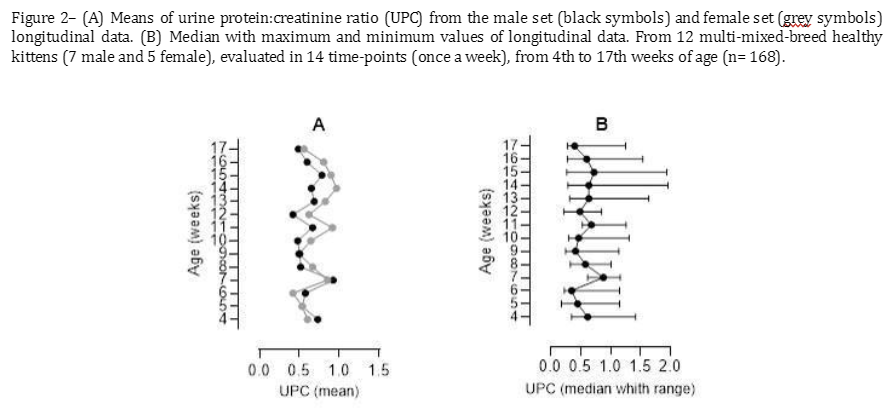Urine protein:creatinine ratio in growing kittens: new insight
DOI:
https://doi.org/10.21708/avb.2024.18.2.12186Abstract
This study aimed to evaluate the urinary excretion of protein employing the urine protein:creatinine ratio in growing health kittens and included twelve clinically healthy multi-mixed-breed kittens, seven males and five females from three different litters. Urine collections started when the kittens completed the fourth week of life. The study followed a controlled longitudinal experimental model, with 14 repeated measures, one per week. A total of 168 urine samples from 12 healthy growing kittens were analyzed. UPC ratio median value was 0.56 (confidence interval 0.51 - 0.62), revealing urinary protein excretion more remarkable than is expected for healthy adult cats. Two-way repeated-measures ANOVA results indicated no statistically significant differences in urine protein:creatinine ratio values concerning the kittens’ ages and genders. Additionally, there was a striking fluctuation of urine protein: creatinine ratio values for all kittens over the 14 weeks (coefficient of variation 53.3%). Urine protein:creatinine ratio of healthy growing kittens changes unexpectedly, and most values reach magnitudes considered pathological for adult cats, suggesting a clinically irrelevant condition. Since the fluctuation of the UPC is not related to age (from the fourth to the seventeenth week of age), to interpret of UPC of growing kittens, in practice or research, it is mandatory to repeat the measures, at least three times, at one week apart, to discharge pathologic event.
Downloads

Downloads
Pubblicato
Fascicolo
Sezione
Licenza
Copyright (c) 2024 Acta Veterinaria Brasilica

TQuesto lavoro è fornito con la licenza Creative Commons Attribuzione 4.0 Internazionale.
Autores que publicam na Acta Veterinaria Brasilica concordam com os seguintes termos: a) Autores mantém os direitos autorais e concedem à revista o direito de primeira publicação, com o trabalho simultaneamente licenciado sob a Licença Creative Commons Attribution que permite o compartilhamento do trabalho com reconhecimento da autoria e publicação inicial nesta revista. b) Autores têm autorização para assumir contratos adicionais separadamente, para distribuição não-exclusiva da versão do trabalho publicada nesta revista (ex.: publicar em repositório institucional ou como capítulo de livro), com reconhecimento de autoria e publicação inicial nesta revista. c) Autores têm permissão e são estimulados a publicar e distribuir seu trabalho online (ex.: em repositórios institucionais ou na sua página pessoal) a qualquer ponto antes ou durante o processo editorial, já que isso pode gerar alterações produtivas, bem como aumentar o impacto e a citação do trabalho publicado (Veja O Efeito do Acesso Livre).


 Esta obra está licenciada com uma Licença
Esta obra está licenciada com uma Licença 